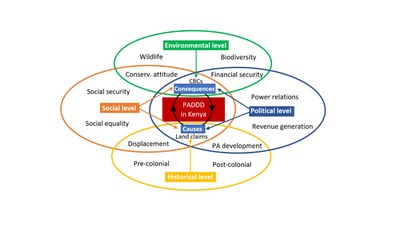The causes and impacts of protected area downgrading, downsizing and degazettement (PADDD) in Kenya and the development of community-based conservation approaches
Kyra Damp
National parks and protected areas (PA) are the centerpiece of efforts to conserve biodiversity. It is therefore assumed, that they are permanent fixtures of the landscape. However, emerging research has shown that the boundaries of PAs and their level of protection regularly change. These processes can be summed up as protected area downgrading, downsizing and degazettement (PADDD). Although there is some ongoing research on the occurrence of PADDD events globally, there has been little research done concerning the drivers, processes and consequences of such changes on a regional scale. In order to better understand these effects, this thesis takes a closer look at the primary cause for PADDD events in Kenya, land-claims, and the consequences that arise for the country’s conservation efforts as well as biodiversity. Furthermore, the research will help understand the relationship between PADDD events and the establishment of community-based conservancies in Kenya. This thesis draws information from two primary data gathering approaches: A structured literature review (SLR) and semi-structured interviews (SSI) for expert consultation. Both approaches disclosed a connection between land-claims and an increasing land pressure together with social pressures following land alienation processes in Kenya. The displacement of locals in Kenya derived from economic purposes of a corrupt government, or conservation purposes of the colonial rule. By restoring rights to previously displaced peoples, PADDD can improve biodiversity outcomes by positively influencing attitudes towards forests and conservation. This relies strongly on how efficiently a community conservancy is managed and how the benefits are distributed financially and environmentally.

